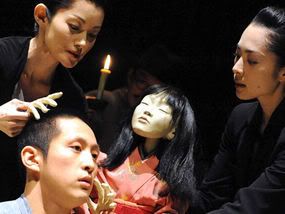
Shun-Kin - Complicite/Simon McBurney
Barbican Theatre 14th February 2009
Its hard to get a moments peace in London. When we're not sat in front of a computer screen listening to our neighbour whine on about their weekend of boozing, we're at home watching the TV or trying to ignore the never ending drone of passing traffic. Maybe the capital is afraid to be quiet for a second in case we realise something about ourselves it doesn't want us to? Instead we are force fed noise pollution down and bombarded with bright colourful moving images to distract and entertain us.
Complicite's latest offering Shun-Kin, performing at the Barbican theatre until 21st February, reminds us of this sad fact. The tale, based on the writings of influential twentieth century Japanese writer Jun'ichiro Tanizaki, follows the blind, beautiful yet deeply spoilt Shun-Kin and her devoted servant Sasuke examining the complex relationship of the two - a relationship full of power, domination, darkness and light. The more Sasuke meets every whim and shrill cry of his sadistic mistress, the more demanding and violent she is, leading to some awkward shuffling in the auditorium and some rather prudish reviews by the more sensitive critics. The thin line that divides love from hate and pleasure from pain is here highlighted, crossed and questioned.
Simon McBurney's mastery over the visual image seems destined to touch on the subtle beauty of Japanese theatre. Scenes do not end but smoothly merge into one another lulling the audience into an almost hypnotic state. This is, of course, not to say it is easy watching. The violence of both Shun-Kin's physical actions and her voice make it, at times, unbearable. But we are transported to another world and another time where the reliance on technology is absent and the hedonistic, selfish existence of the modern age is replaced with a selfless commitment to duty. Highlighting this point beautifully, members of Tokyo's Setagya Public Theatre create representation of birds, trees, doors and even Shun-Kin who, for the most part, is a skillfully manipulated marionette.
It is not until the climax of the performance, with the death of Shun-Kin and, years later, her still dedicated servant, that there is a final, definite transition from darkness to the light. But this move to the light comes as a warning. Because as we leave the darkness of 19th century Japan and enter the light of contemporary culture, complete with its flashing neon and constant buzzing noise, we also leave behind the ability to see and to hear clearly. An ability we may never get back.
Lily Eckoff





No comments:
Post a Comment